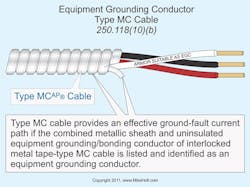All questions and answers are based on the 2011 NEC.
Q. What types of equipment grounding conductors does the NEC allow?
A. An equipment grounding conductor can be any one or a combination of the following [250.118]:
1) A bare or insulated copper or aluminum conductor sized in accordance with 250.122.
2) Rigid metal conduit (RMC).
3) Intermediate metal conduit (IMC).
4) Electrical metallic tubing (EMT).
5) Listed flexible metal conduit (FMC) where:
a. The raceway terminates in listed fittings.
b. The circuit conductors are protected by an overcurrent device rated 20A or less.
c. The combined length of the flexible conduit in the same ground fault current path doesn’t exceed 6 ft.
d. If flexibility is required to minimize the transmission of vibration from equipment or to provide flexibility for equipment that requires movement after installation, an equipment grounding conductor of the wire type must be installed with the circuit conductors in accordance with 250.102(E), and it must be sized in accordance with 250.122, based on the rating of the circuit overcurrent device.
6) Listed liquidtight flexible metal conduit (LFMC) where:
a. The raceway terminates in listed fittings.
b. For 3⁄8 in. through ½ in., the circuit conductors are protected by an overcurrent device rated 20A or less.
c. For ¾ in. through 1¼ in., the circuit conductors are protected by an overcurrent device rated 60A or less.
d. The combined length of the flexible conduit in the same ground fault current path doesn’t exceed 6 ft.
e. If flexibility is required to minimize the transmission of vibration from equipment or to provide flexibility for equipment that requires movement after installation, an equipment grounding conductor of the wire type must be installed with the circuit conductors in accordance with 250.102(E), and it must be sized in accordance with 250.122, based on the rating of the circuit overcurrent device.
8) The sheath of Type AC cable containing an aluminum bonding strip. Note: The internal aluminum bonding strip isn’t an equipment grounding conductor, but it allows the interlocked armor to serve as an equipment grounding conductor because it reduces the impedance of the armored spirals to ensure that a ground fault will be cleared. It’s the aluminum bonding strip in combination with the cable armor that creates the circuit equipment grounding conductor. Once the bonding strip exits the cable, it can be cut off because it no longer serves any purpose. The effective ground-fault current path must be maintained by the use of fittings specifically listed for Type AC cable [320.40]. See 300.12, 300.15, and 320.100.
9) The copper sheath of Type MI cable.
10) Type MC cable that provides an effective ground fault current path in accordance with one or more of the following:
a. It contains an insulated or uninsulated equipment grounding conductor in compliance with 250.118(1).
b. The combined metallic sheath and uninsulated equipment grounding/bonding conductor of interlocked metal tape-type MC cable that’s listed and identified as an equipment grounding conductor, as shown in the Figure. Note: Once the bare aluminum grounding/bonding conductor exits the cable, it can be cut off because it no longer serves any purpose. The effective ground fault current path must be maintained by the use of fittings specifically listed for Type MCAP cable [330.40]. See 300.12, 300.15, and 330.100.
c. The metallic sheath or the combined metallic sheath and equipment grounding conductors of the smooth or corrugated tube-type MC cable that’s listed and identified as an equipment grounding conductor.
11) Metallic cable trays where continuous maintenance and supervision ensure only qualified persons will service the cable tray, with cable tray and fittings identified for grounding and the cable tray, fittings [392.10], and raceways are bonded using bolted mechanical connectors or bonding jumpers sized and installed in accordance with 250.102 [392.60].
13) Listed electrically continuous metal raceways, such as metal wireways [Art. 376] or strut-type channel raceways [384.60].
14) Surface metal raceways listed for grounding [Article 386].
Note: The equipment grounding conductor is intended to serve as the effective ground fault current path. See 250.2. The effective ground fault path is an intentionally constructed low-impedance conductive path designed to carry fault current from the point of a ground fault on a wiring system to the electrical supply source. Its purpose is to quickly remove dangerous voltage from a ground fault by opening the circuit overcurrent device [250.2].
Q. When does the Code allow a building to be served by more than one service?
A. A building/structure can only be served by one service drop or service lateral, except as permitted by 230.2(A) through (D).
(A) Special Conditions. Additional services are permitted for the following:
1) Fire pumps
2) Emergency systems
3) Legally required standby systems — Note: A separate service for emergency and legally required systems is permitted only when approved by the authority having jurisdiction [700.12(D) and 701.11(D)].
4) Optional standby power systems
5) Parallel power production systems
6) Systems designed for connection to multiple sources of supply for the purpose of enhanced reliability. Note: To minimize the possibility of accidental interruption, the disconnecting means for the fire pump, emergency system, or standby power system must be located remotely away from the normal power disconnect [230.72(B)].
(B) Special Occupancies. By special permission, additional services are permitted for:
1) Multiple-occupancy buildings where there’s no available space for supply equipment accessible to all occupants, or
2) A building or other structure so large that two or more supplies are necessary.
(C) Capacity Requirements. Additional services are permitted:
1) If the capacity requirements exceed 2,000A, or
2) If the load requirements of a single-phase installation exceed the utility’s capacity, or
3) By special permission. Note: Special permission is defined in Art. 100 as “the written consent of the authority having jurisdiction.”
(D) Different Characteristics. Additional services are permitted for different voltages, frequencies, or phases, or for different uses, such as for different electricity rate schedules.
(E) Identification of Multiple Services. If a building/structure is supplied by more than one service or a combination of feeders and services, then a permanent plaque or directory must be installed at each service and feeder disconnect location to denote all other services and feeders supplying that building/structure, and the area served by each.
Q. What is the Code rule regarding supporting of festoon lighting?
A. Overhead conductors for festoon lighting must not be smaller than 12 AWG, unless messenger wires support the conductors. The overhead conductors must be supported by messenger wire, with strain insulators, whenever the spans exceed 40 ft in length [225.6(B)]. Note: Festoon lighting is a string of outdoor lights suspended between two points [Art. 100]. It’s commonly used at carnivals, circuses, fairs, and Christmas tree lots [525.20(C)].
Holt is the owner of Mike Holt Enterprises, Inc. in Leesburg, Fla. He can be reached at www.mikeholt.com.About the Author

Mike Holt
Mike Holt is the owner of Mike Holt Enterprises (www.MikeHolt.com), one of the largest electrical publishers in the United States. He earned a master's degree in the Business Administration Program (MBA) from the University of Miami. He earned his reputation as a National Electrical Code (NEC) expert by working his way up through the electrical trade. Formally a construction editor for two different trade publications, Mike started his career as an apprentice electrician and eventually became a master electrician, an electrical inspector, a contractor, and an educator. Mike has taught more than 1,000 classes on 30 different electrical-related subjects — ranging from alarm installations to exam preparation and voltage drop calculations. He continues to produce seminars, videos, books, and online training for the trade as well as contribute monthly Code content to EC&M magazine.


